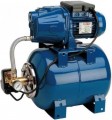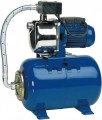Maximum performance
The maximum volume of water that the device can pump in a certain amount of time. It is one of the key specs of any pump because characterizes the volume of water with which the device can work. At the same time, it does not always make sense to pursue maximum performance — after all, it significantly affects the dimensions and weight of the unit.
Some formulas allow you to derive optimal performance values for different situations. So, if the pump is designed to supply water to water intake points, its minimum required performance should not be lower than the highest total flow rate; if desired, a margin of 20-30% can be added to this value. And for sewer models (see "Suitable for"), everything will depend on the volume of wastewater. More detailed recommendations for choosing a pump depending on performance can be found in special sources.
Maximum head
The maximum head generated by the pump. This parameter is most often indicated in meters, by the height of the water column that the unit can create — in other words, by the height to which it can supply water. You can estimate the pressure created by the pump using a simple formula: every 10 m of head corresponds to a pressure of 1 bar.
It is worth choosing a pump according to this parameter, taking into account the height to which it should supply water, as well as adjusting for losses and the need for pressure in the water supply. To do this, it is necessary to determine the difference in height between the water level and the highest point of water intake, add another 10 to 30 m to this figure (depending on the pressure that needs to be obtained in the water supply), and multiply the result by 1.1 — this will be the minimum pressure required.
Max. pressure
The highest pressure that the pump is capable of creating during operation. This parameter is directly related to the maximum head (see above); however, it is less obvious, and therefore, it is indicated rarely.
Maximum liquid temperature
The highest temperature of water at which the pump is capable of operating normally. Usually, in most models this parameter is 35-40 °C — at high temperatures it is difficult to ensure effective cooling of the engine and moving parts, and in fact, such conditions are rare.
Volume of water pressure tank
The volume of the water pressure tank provided in the design of the pressure tank unit.
A water pressure tank is a reservoir capable of holding a certain volume of water. It performs several functions at once. The main ones are: firstly, maintaining a stable pressure; secondly, protection against water hammer; and thirdly, storage of an “emergency” supply of water in case of a power outage, pump breakdown, etc. The larger the volume of this tank, the better it handles its capabilities; on the other hand, a large capacity significantly affects the dimensions and cost of the tank. Therefore, it does not always make sense to look for a pump with the maximum volume of the water pressure tank. Specific recommendations on choosing the optimal volume for different situations can be found in special sources.
Maximum power
Rated power of the pump motor. The more powerful the engine, the higher the performance of the unit, usually, the greater the pressure, suction height, etc. Of course, these parameters largely depend on other features (primarily the pump type, see above); but models similar in design can be compared in terms of power.
Note that high power, usually, increases the size, weight and cost of the pump, and also implies high costs of electricity or fuel (see "Power source"). Therefore, it is worth choosing a pump according to this parameter taking into account the specific situation; more detailed recommendations can be found in special sources.
Noise level
The noise level produced by the pump during normal operation. For comparison, 50 decibels roughly corresponds to the noise in an office room, 60 dB to an average TV volume, 70 dB to a truck at a distance of about 8 m, 80 dB to traffic noise, and 90 dB to a scream. The lower the noise level, the more comfortable the use of the pump and the closer it can be placed to people. This parameter is especially important for models designed for indoor installation.
Pump housing material
The material from which the pump housing is made. It is a structural element in which the working mechanism (impeller or auger) is installed. Note that the motor casing can be made of a different material — this is not important in this case; and in water pumps with the engine (see “Power source”), we are talking about the casing of the pump itself, and not about the support frame in which it is fixed.
The following options are most popular nowadays:
— Plastic. Inexpensive material that perfectly resists moisture and is not subject to corrosion. However, the reliability of plastic as a whole is not very high; the exception is special high-strength grades, but they are extremely rare in pumps (when strength is needed, metals are usually used). So plastic housing is mainly equipped with relatively simple and affordable models that are not designed for serious loads.
— Cast iron. An extremely popular material nowadays: cast iron is strong, reliable, durable and at the same time has a relatively low cost. However, in terms of corrosion resistance, this material is inferior to stainless steel (see below). Nevertheless, subject to the rules for operating the pump, the service life of the cast-iron housing is not inferior to the service life of most of the main components of the unit. Also note that such cases are quite massive, which makes transportation difficult; however, in some cases, a large weight is an advantage: it helps to dampen vibrati...ons.
— Stainless steel. By the name, one of the key advantages of stainless steel is high resistance to corrosion — and, accordingly, reliability and durability. On the other hand, this material also costs a little more than the same cast iron. The weight of such housing is somewhat less — this, again, can be both an advantage and a disadvantage, depending on the situation.
— Aluminium. Premium material. The aluminium alloys used in today's pumps are light, strong, durable, and virtually impervious to moisture, but cost accordingly.
— Brass. A fairly rare option found in some models of surface pumps. Brass is strong enough, reliable and resistant to moisture, but in most cases, it does not have key advantages over the same stainless steel or aluminium but costs a little more.
— Bronze. Another material similar to the brass described above is durable and practical but rarely used.
— Ceramics. A material found exclusively in sewage pumps in the form of toilet bowls (see "Pump design"). Most often, ceramics means vitreous china or more expensive and durable vitreous china — that is, the same materials as in ordinary toilets without built-in pumps.

